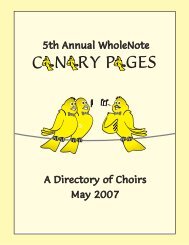September 2009 - The Wholenote Magazine
September 2009 - The Wholenote Magazine
September 2009 - The Wholenote Magazine
- No tags were found...
Create successful ePaper yourself
Turn your PDF publications into a flip-book with our unique Google optimized e-Paper software.
oth cast in a traditional three movementfast-slow-fast framework yet exhibit a veryindividual melodic approach that is remarkablycompelling. Restricting himself for themost part to easily comprehensible two partcounterpoint, Kleiberg composes long linesof chromatically inflected strands of everevolvingmelodies that captivate the listenerthrough a process of seamless organic metamorphoses.Decidedly post-modern in theirallegiance to tonality, these concertos exhibithighly effective and idiomatic string writing.This is especially evident in his double bassconcerto. For such a burly fellow, the soul ofthe contrabass is at heart rather melancholy,intimate and a bit clumsy, and a real challengeto compose for. Soloist Sjölin performsmiracles in the many extended passages inthe highest register and is rock-solid in hisperformance of the luminous sections composedentirely from the natural harmonics ofthe instrument. <strong>The</strong>re’s never a dull momentin either of these eminently accessible works.Highly recommended.Daniel FoleyShort Stories - American music forsaxophone quartetAncia Saxophone QuartetNaxos 8.559616Borrowing from popular music has almostdefined American “classical” music sincethe time of Ives, and the Ancia SaxophoneQuartet hascompiled a discof commissionsand favouritesthat captureTwentieth CenturyAmerica.<strong>The</strong> Choralefrom Ives’String QuartetNo. 1 opensthis disc, which also includes the third movementof his Fourth Symphony. Ives wouldhave embraced the organ-like sound of thesaxophone quartet for his collage of hymns.<strong>The</strong> influence of Elliott Carter can be seenin Fred Sturm’s Picasso Cubed (a reworkingof a Coleman Hawkins improvisation, perhapsas seen through a kaleidoscope), and inDavid Bixler’s Heptagon (seven short jazzyWebernesque movements). Accordionist DeeLangley joins for Elusive Dreams, wherecomposer Carleton Macy demonstrates howwell the instrument blends with saxophones.<strong>The</strong> minimalist movement is represented byMichael Torke’s July. Written one hundredyears after the Ives, Torke also likes to borrowfrom popular music: “Whenever I am drawnto a particular… pop song, I scratch my headand think, ‘I like that, how could I use it?’”Jennifer Higdon – who is popular now inthe orchestral world – wrote the title track,Short Stories, for the Ancia Quartet. Eachpicturesque movement invokes a film whilelistening. Higdon knows each instrument, andwrites very well for saxophone quartet.<strong>The</strong> American Classics Series on NAXOScontinues to record a wide range of musicand artists, and Ancia’s disc is an enjoyablelisten.Wallace HalladayJAZZ AND IMPROVISEDJust FriendsCanadian Jazz QuartetCornerstone CRST CD 133<strong>The</strong> Canadian Jazz Quartet (Gary Benson,guitar, Frank Wright, vibraphone, DuncanHopkins, bass and Don Vickery, drums) hasbeen an important part of the Canadian scenesince 1987 - important because they havemaintained amusical philosophyofplaying greatstandards andmaking musicthat swings. Individuallytheyare all talented,experienced soloistsand as agroup they blend beautifully. For this recording,the CJQ invited three guests to contributeone number each. Trombonist Alastair Kaygives a virtuoso performance on Memories ofYou, master flutist Bill McBirnie adds a Latintouch with Blue Bossa and Mike Murleyon tenor sax romps through the title track,Just Friends. <strong>The</strong> remaining titles make upa cross-section of great standards and showtunes ranging from Gershwin’s EmbraceableYou to Clifford Brown’s Joy Spring.This album also gives an all too rare opportunityfor the playing of guitarist GaryBenson and vibes player Frank Wright to beheard by a wider audience. Frank’s renditionof Where Are You, for example, is a thingof beauty and just listen to how Gary glidesthrough Have You Met Miss Jones. <strong>The</strong> DDs,(Hopkins and Vickery), make the whole thingswing like the pendulum of a finely oiledclock as well as contributing some fine solos.All told “Just Friends” is an excellent exampleof discriminating taste and musicalityand will occupy a pleasurable hour of any dayor evening.Jim GallowayNostalgia<strong>The</strong> Andrew Scott Quintet meets Jon-ErikKellso and Dan BlockSackville SKCD2-2073<strong>The</strong> bebop era saw the extended use of standardpopular songs as the basis for new compositionsbased on the chord changes of thefamiliar themes.“Nostalgia” takes this as its basic premisewith a programme of compositions by musician/composerssuch as Tadd Dameron,Barney Kessel, Fats Navarro, Charlie Parker,Gigi Gryce, Zaid Nasser and one by leaderAndrew Scott and Jake Wilkinson. Havingsaid that, the first selection is Ben Webster’sDid You Call Her Today, his swing stylevariation onRose Room,but for the restof the albumit’s bebop linesover familiarstandard harmonies.If you area jazz buff, seehow many youcan get rightbefore looking at the liner notes!Pianist Mark Eisenman, bassist Pat Collinsand drummer Joel Haynes integrate beautifullyand Mark contributes some outstandingsolos, while Andrew Scott is equally comfortableplaying unison lines, comping or stretchingout on a solo.Trumpeter Jon-Erik Kellso and clarinettistDan Block, although of a later generation,have chosen to follow in the steps of the greatearly innovators and both play with lyricalconcept, creative ideas and the playing skillsto make it all come together. As John Norrisrightly states in his accompanying notes,they are indeed real jazz musicians. This CDis a welcome addition and upholds the wellearned stellar reputation of Sackville Records.Jim GallowayLive in VancouverRichard Whiteman TrioCornerstone CRST CD 131(www.richardwhiteman.com)Pianist Richard Whiteman has been workingas a leader and sideman in the greaterToronto area for over twenty years. A polishedplayer whether you prefer bebop ora ballad, Whiteman has recorded six timesunder his ownname, includingthe aptly titled“Solo Piano”and the criticallyacclaimed“Grooveyard”.As a leader heworks frequentlyin the traditionof piano,bass & drums, arrangements echoing theglorious trios of Peterson, Evans and Jamal.After recording on the Cornerstone label withsuch Canadian luminaries as bassists MikeDownes and Neil Swainson and drummersJohn Sumner and Barry Elmes, his latest triois completed by Brandi Disterheft on the bassand Sly Juhas on the skins. <strong>The</strong> pair share anexciting chemistry that reflects countless gigsplayed since their years at Humber Collegeearly in the new millennium. Whiteman givesboth Disterheft and Juhas generous time toshine on this fine live recording. <strong>The</strong> eighttracks represent the best of what was recordedby Cory Weeds at <strong>The</strong> Cellar over twonights in February, 2008. An 11’39” takeon I’m Confessin’ gives each player a niceopportunity to stretch out, the original Bluesfor Jervis is a cheerful one and <strong>The</strong> Song<strong>September</strong> 1 - October 7, <strong>2009</strong> WWW.THEWHOLENOTE.COM 53
















